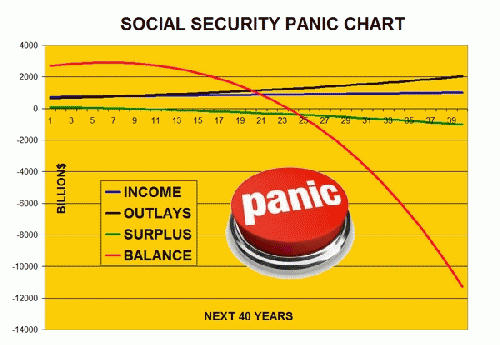te title="Social Security Panic Chart" class="wwscontentsmaller">Social Security Panic Chart by Larry Butler
Yesterday's news from ADP confirms a long term trend: jobs are being added to the economy at a pace that falls short of overall economic growth. Not coincidentally, increases in labor productivity are at a four-year high. Elsewhere in the news, Social Security is depicted as "on the ropes" by the wealthy, their corporations, and their neocon shills.
Let's examine just how these things are interconnected, and consider what they mean to our economic and social future. Make sure you're up on your meds - you may be in for a shock if you haven't been keeping up - and read all the way to the end; there's a hint of a solution there.
One of the myths perpetrated by the business community and its mouthpieces in government is that business investment yields jobs. Tax policy, public policy, and economic policy have all vigorously encouraged and even directed the investment of capital through incentives of all kinds. But instead of yielding jobs, these policies have yielded profits instead.
As a result, corporate profits have assumed a more prominent
position in the national economy, now accounting for a larger percentage of
gross domestic product -- GDP. Forty
years ago, corporate profits averaged 26.8% of GDP. Since then, the figure has edged upward, and
for the three years ended 2012 averaged 29.5%.
Although this may seem like a subtle change, it's applied to a very
large number today, amounting to a shift of $433 billion annually from personal
income to corporate income. (US Bureau
of Economic Analysis, Table 1.7.5,
Increases in corporate profits tend to yield greater
interest, dividends, and capital gains for corporate investors. This has shifted an even higher proportion of
GDP from earned income to passive income -- the kind enjoyed by capitalists
rather than employed workers. Forty
years ago, the figure averaged 18.5% of GDP.
Since then the figure has jumped upward, and for the three years ended
2012 averaged 26.5%. This not-so-subtle
change accounts for a shift of more than $1.2 trillion annually from earned
income to passive income. (US Bureau of
Economic Analysis, Table 1.7.5,
The rise of corporations in
Evaluating the consequences of this rise in corporate
profits leads to the inevitable conclusion that the concentration of wealth in
Social Security does have a problem, and solutions are needed. Old Age and Survivors Insurance -- OASI -- will pay out $645 billion in FY 2012 to retirees and their dependents. Working Americans are expected to contribute $731 billion to bolster by $86 billion the $2.7 trillion balance of the Social Security trust that funds these disbursements, despite the "big money" going out. But this will soon change because of the mass retirement of aging boomers; by 2034, the money will be gone.
Why is Social Security in trouble? Taxes that support OASI payments do not apply to corporate profits, passive income, or earned income above modest limits. And this is the kind of income that has increased its share of GDP in recent decades. Consider what would happen if the shift in income had not occurred at all. First, by un-redistributing $433 billion from corporate profits to wages and salaries, the trust fund would receive an additional $54 billion annually. Second, by un-redistributing $1.2 trillion from interest, dividends, and capital gains to wages and salaries, the trust fund would receive an additional $152 billion annually. Add to this $200 billion annual windfall the un-redistribution of executive compensation to rank-and-file workers, and the trust fund would receive an additional sweetener. Together, these un-redistributions would have yielded a surplus approaching $300 billion in 2012. But instead, the Social Security trust fund and our retirement benefits are threatened; this is a direct consequence of the redistribution of income that has occurred over the past thirty years.
Phony solutions have been proposed. The Heritage Foundation, among other
regressives, suggests that privatizing Social Security is a good fix. The Federal Reserve doesn't agree, saying, "Comparing
a privatized alternative with the current system via simulation, we document
that choice in both equity allocation and equity composition lead to increased
income inequality and risk of shortfalls relative to currently promised
benefits." The Fed has succinctly identified this
strategy as a scheme to accelerate the concentration of wealth rather than one
to "save" Social Security.
If the redistribution of income and wealth caused the OASI shortfalls we expect in future years, the long-term solution must be found in unwinding this redistribution. Redistribution evolved through the manipulation, by corporations and the wealthy, of taxation, regulation, and enforcement -- public policies. Of these, the most powerful tool has probably been taxation.
Today's US income tax code favors corporations that can exploit its complexity, and wealthy individuals whose income is derived from investments. The code is fraught with incentives and penalties that take away our ability to make objective decisions about marriage, family size, home ownership, investment, retirement, or even the purchase of a family car. The code is so complex, the IRS says it leaves $300 billion a year on the table that it just can't find. And the latest news shows that the multiple roles of the IRS prevent them from accomplishing any of their goals gracefully.
So the solution to all kinds of things -- including the salvation of Social Security -- is to throw out the income tax code and replace it completely, with something like this".. Each person would be allowed $48,000 per year in tax-free income from any source, above which a tax rate of 24% would be applied. There would be no deductions, exemptions, or credits. Corporate income (GAAP) would be treated the same, except that dividends paid would be deducted from taxable net income. The first result would be to cut the annual budget deficit in half! With more money in the hands of those most likely to spend it, economic stimulus would follow.
Better yet, the tax code would become a level playing field. And a giant step would be taken toward eliminating the favors that have led to increased concentration of income. By making it possible for wage and salary earners to compete for a normalized share of GDP, contributions to the Social Security trust fund will increase. More needs to be done, of course, with regard to regulation of corporate influence. But Social Security can be saved by replacing the income tax system with one that stops, and even reverses, the continued re-distribution of income and wealth to corporations and rich individuals.





